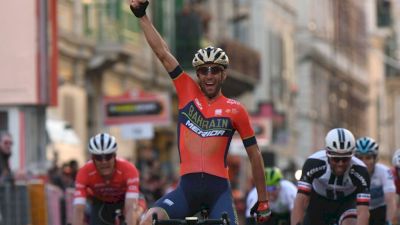Nibali's Secret To Winning Milano-Sanremo
Nibali's Secret To Winning Milano-Sanremo
Vincenzo Nibali explains what it takes to win Milano-Sanremo, a race suspended due to the Coronavirus outbreak.

Unlock this article, live events, and more with a subscription!
Already a subscriber? Log In
Italian Vincenzo Nibali (Trek-Segafredo) explains what it takes to win Milano-Sanremo, which will not be held tomorrow due to the Coronavirus outbreak.
Nibali rode away solo on the Poggio climb to claim the Italian Monument in 2018. It was a shock since years had passed since someone could succeed with such a move from the final climb to the finish.
"If there's one thing, it's that every time that I raced Milano-Sanremo when I felt well or I could do something, I tried an attack on the last climb or the second last," Nibali told FloBikes.
"But I think that the Cipressa, even if it's a little bit harder, it's a little too far from the finish. It's harder to do something from there, and it also depends on the wind.
"But the Poggio is a good launch pad. But it's hard, it's not simple and it depends on the wind, how the race was ridden to the that point, if it was a slower or faster race."
The Cipressa and then the Poggio climbs close out the race, both small villages are reached from roads off the main coastline heading west towards Sanremo.
Sometimes sprinters survive a small group to win. Other times, a group of attackers ride free over the climbs, like with Alaphilippe in 2019. Rarely does a Grand Tour rider like Nibali ride solo from the Poggio to the finish 5.4 kilometres later.
"I was feeling very good, I came out of Tirreno-Adriatico on the rise. In the following days I felt that I was in condition, my legs were good, but I didn't have intentions to do something, we had [Sonny] Colbrelli, so it was all for him, and if there was a move, I needed to be present. That move happened, and my condition allowed me to be there," continued Nibali.
"I was in second or third [at the start], taking most of the climb at the front, and when the attack happened, I was right there to follow. In the first moment, I didn't help, but when I saw that we had a good advantage, when I turned around, I saw that gap, and thought, 'Wow, I need to try something here.'"
Nibali counter-attacked Krists Neilands and rode away.
"My teammates were waiting behind, it was up to the other teams to try to close the gap and get me. I'd risked some, but not too much to the bottom of the descent, I knew that I'd have to push even more on that flat part to get to the Via Roma with the right gap," he said.
"When I saw at 500 metres, I was there, with the right gap.
"I thought, 'I can't believe I've done it.' It was an explosion of joy, so incredible. I can say that day I felt truly super."